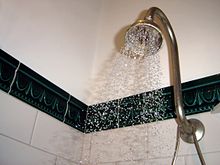Shower
This article may require copy editing for grammar, style, cohesion, tone, or spelling. (June 2007) |
It has been suggested that Steam shower be merged into this article. (Discuss) Proposed since May 2007. |
A shower is a process of bathing by application of sprayed water upon the body; the term also refers the component of a typical modern bathroom that provides such a function. It offers an effective method of personal hygiene through a spraying of the body with hot or cold water as desired, often in combination with soap, shampoo or shower gel. It is also a more efficient use of water and the power necessary to heat it than taking a bath. By definition, a half bathroom does not include a shower; a full bath may include a full shower.
History
The hygiene regimen in the form of a shower goes back to the time of the Greeks, as evidenced by extant vases and murals.[1] It would take some time until the general spread of showering occurred. During the Scottish Enlightenment Lord Monboddo showered every morning with cold water on his front porch to emulate the Greeks and profess his belief in the practise as healthful;[1] his habit, while eccentric, was well publicised with the intelligentsia of that era. Another step toward the spread of showering was when the Prussian military installed showering rooms in their barracks in 1879.
Cultural significance

Showering in the Western World is mostly part of a daily routine, but is also practiced for wellness and relaxation. Showering has today largely replaced bathing. Many households today do not own a bathtub any more, but rather a shower in its place.[citation needed]
Showering procedure
Showering results in a few phases, in which the skin, and sometimes the hair, are wet with water. Then the cleansing products are applied, allowed to work, and subsequently rinsed out. If necessary, soaping and rinsing is re-performed.
Too frequent showering with cleansing products can damage the skin and hair. In order to protect the hair, a shower cap may be used.
Constant use of soaps or soap-based products in the shower can produce soap scum on the walls or floors, caused by the reaction of soap with lime in hard water. One of the advantages of using a shower gel instead of soap is that this soap scum does not form, reducing cleaning and maintenance of the shower.
Purpose
Various purposes of showering include routine hygiene, as well as safety (as in chemical spills, mass decontamination, etc.).

Structure and designs

There are free-standing showers, but also showers which are integrated into a bathtub. Showers are separated from the surrounding area through watertight curtains (shower curtain), sliding doors, or folding doors, in order to protect the space from spraying water. There are seldom floor-level showers. Here, the wall and floor of the shower areas are tiled or otherwise made waterproof.
Places such as a swimming pool, a locker room, and a military facility, have multiple showers. There may be shower rooms without divisions (typically sex-segregated) or shower stalls (typically open at the top; often in shower rooms which are sex-segregated anyway).
Anthony David Rueli of the University of Massachusetts researched the aspect of why shower curtains billow inwards during showering ("shower-curtain effect") and received for it the Ig Nobel Prize in 2001.
A shower head is a perforated nozzle that showers water on a bather. They can be modified to spray different patterns of water. Due to hard water, calcium and magnesium often cake and dry on it, causing it to malfunction.
See also
- Balneotherapy
- Bathing
- Bathroom
- Communal shower
- Gatorade shower
- Hydrotherapy
- Navy shower
- Nudity in physical education
- Pressure balanced shower valve
- Public bathing
- PUVA bath therapy
- Sauna
- Sharko Shower
- Shower curtain
- Shower gel
- Sonic shower
- Steam shower
- Thermal bath
- Vichy shower
References
- ^ Cloyd, E.L., James Burnett, Lord Monboddo (1972)
